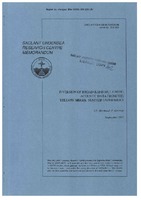| dc.description.abstract | Integral geoacoustic properties of the sea bottom were determined from full-field inversion of broad-band, waterborne, acoustic propagation data. The data were obtained during the YELLOW SHARK 94 experiment along a 15-km mildly range-dependent transect at a shallow water site in the western Mediterranean. Seven tones from 200 Hz to 800 Hz were transmitted simultaneously by a mid-depth acoustic projector, bottom-moored at different ranges from a vertical array that spanned that water column below the thermocline. Extensive oceanographic and geophysical information were obtained in situ to support and validate the inversion. Matched-field pressing was applied to the received pressure fields for each tone frequency. Optimization of the environmental parameters was performed simultaneously across all propagated frequencies. A maximum-likelihood objective function included the linear (Bartlett) cross corielator at the individual frequencies. Genetic algorithms searched for the global minimum of thisobjective function. The convergence and accuracy of the inversion were determined from statistical analysis of the a posteriori distribution of the candidate environmental models produced by the search algorithm. The following conclusions were drawn from this study: 1) For a fixed source-vertical array configuration broad-band tomographic measurements were a sine qua non to obtain meaningful inversion results. 2) The broad-band inversion provided considerable stability and robustness with respect to volume and bottom variabilities. 3) Corresponding single-frequency inversions performed under the exact same conditions produced erratic results. 4) Integral geoacoustic properties were obtained by including the range dependence of ocean sound-speed profile in the forward modeling. 6) The broad-band-inverted sound-speed profile, attenuation, density, and thickness of the top clay layer, and sound speed of the underlying silt layer, were in close agreement with the independent geophysical measurements. | |
